Unit 6 Space and beyond Understanding ideas 课件(共45张,内嵌视频)-高中英语外研版(2019)选择性必修第四册
文档属性
| 名称 | Unit 6 Space and beyond Understanding ideas 课件(共45张,内嵌视频)-高中英语外研版(2019)选择性必修第四册 |  | |
| 格式 | pptx | ||
| 文件大小 | 80.8MB | ||
| 资源类型 | 教案 | ||
| 版本资源 | 外研版(2019) | ||
| 科目 | 英语 | ||
| 更新时间 | 2025-04-24 19:29:06 | ||
图片预览

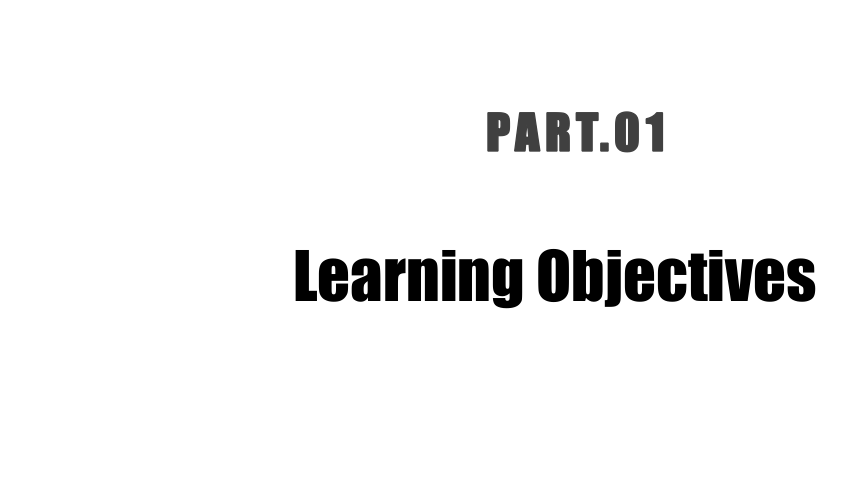
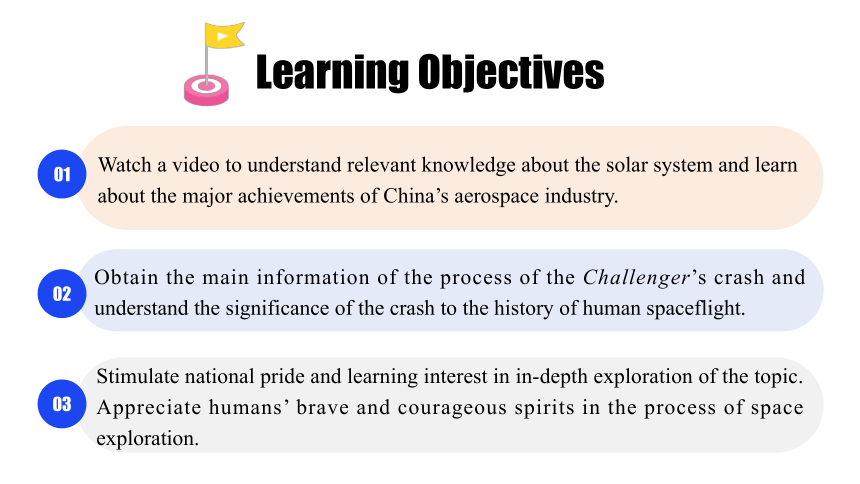
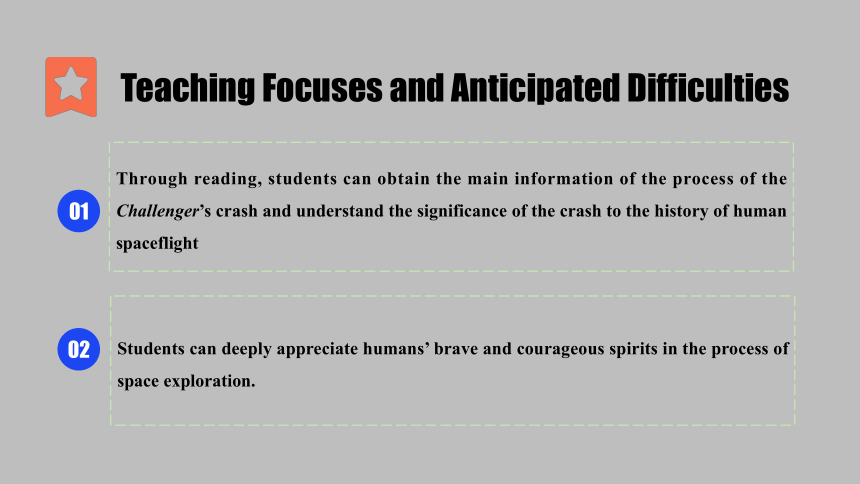

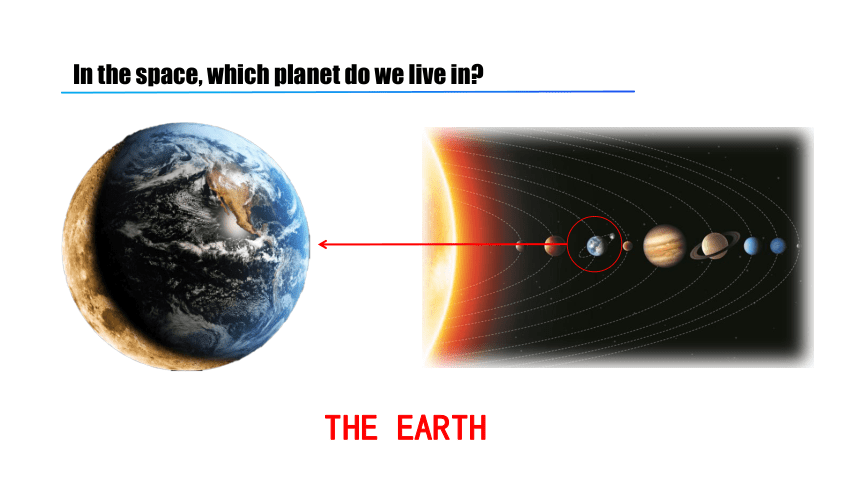
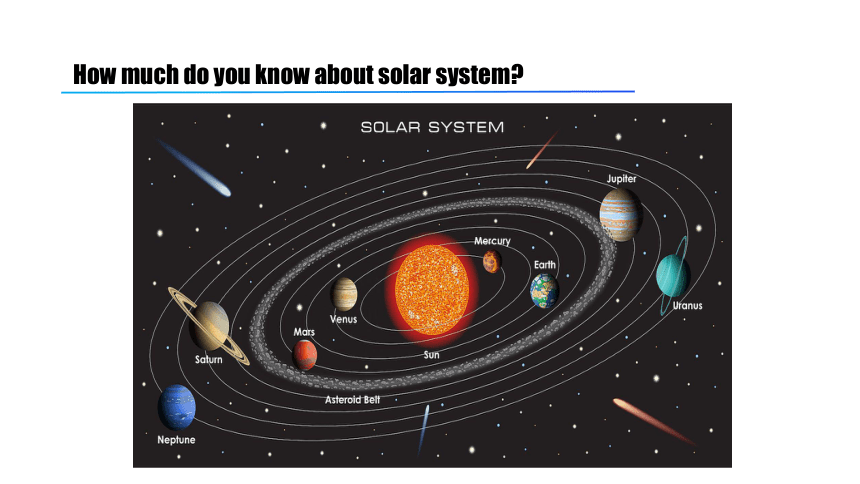
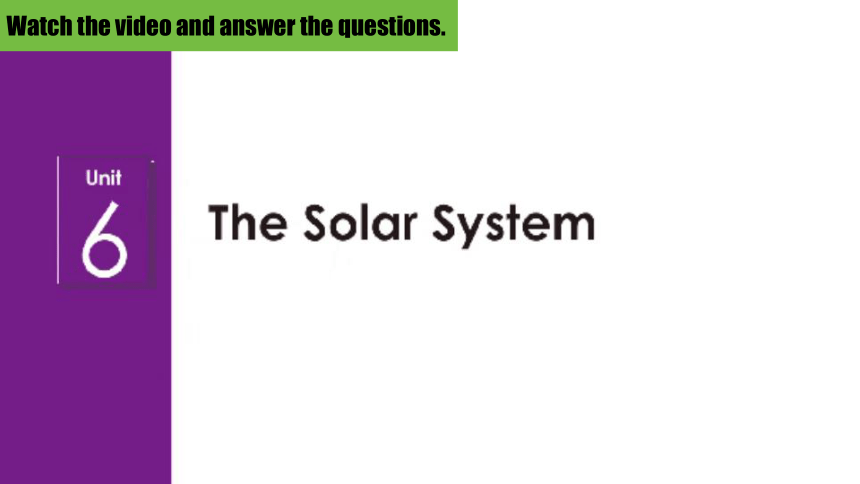
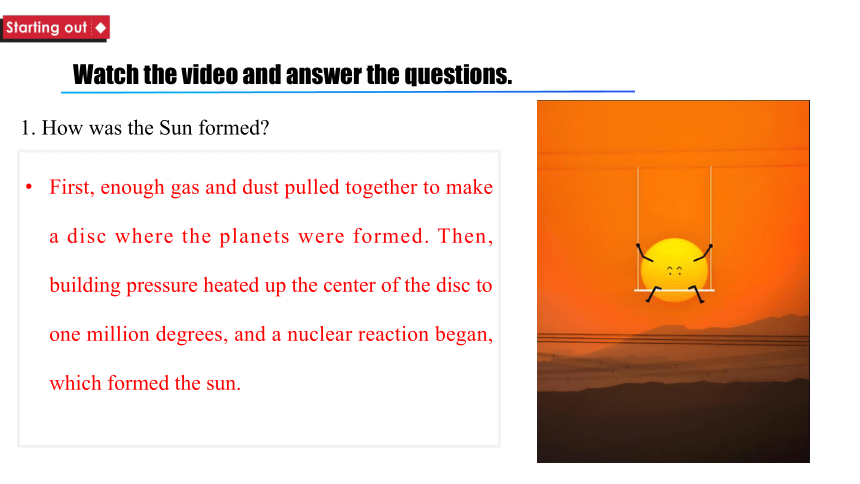

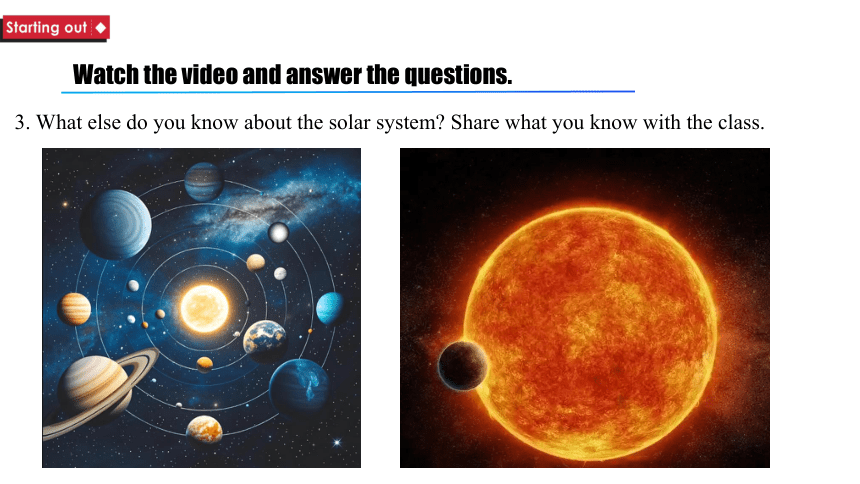
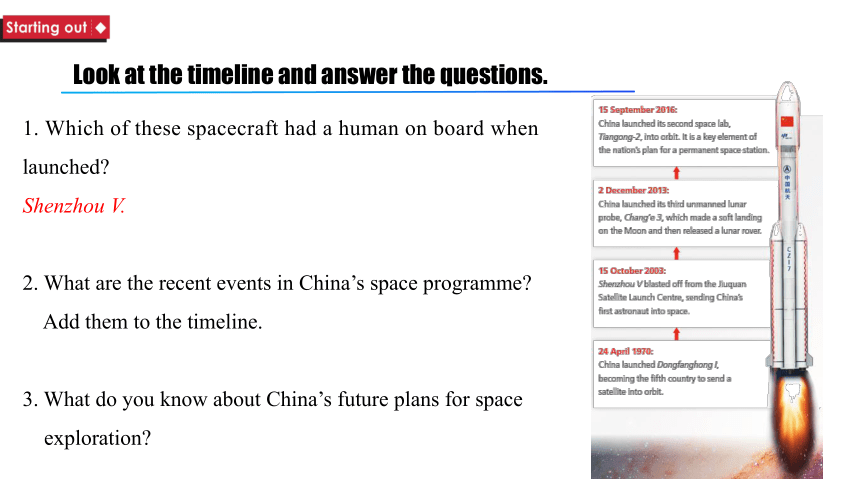
文档简介
(共45张PPT)
Space and beyond
Unit 6
PART.01
Learning Objectives
Watch a video to understand relevant knowledge about the solar system and learn about the major achievements of China’s aerospace industry.
01
Stimulate national pride and learning interest in in-depth exploration of the topic. Appreciate humans’ brave and courageous spirits in the process of space exploration.
03
Obtain the main information of the process of the Challenger’s crash and understand the significance of the crash to the history of human spaceflight.
02
Learning Objectives
Through reading, students can obtain the main information of the process of the Challenger’s crash and understand the significance of the crash to the history of human spaceflight
Students can deeply appreciate humans’ brave and courageous spirits in the process of space exploration.
01
02
Teaching Focuses and Anticipated Difficulties
PART.02
Lead-in
In the space, which planet do we live in
THE EARTH
How much do you know about solar system
Watch the video and answer the questions.
1. How was the Sun formed
Watch the video and answer the questions.
First, enough gas and dust pulled together to make a disc where the planets were formed. Then, building pressure heated up the center of the disc to one million degrees, and a nuclear reaction began, which formed the sun.
01
2. Where are the Asteroid Belt and the Kuiper Belt in the solar system
The Asteroid Belt lies between Mars and Jupiter.
The Kuiper Belt exists just beyond the orbit of Neptune.
01
Watch the video and answer the questions.
3. What else do you know about the solar system Share what you know with the class.
01
Watch the video and answer the questions.
02
Look at the timeline and answer the questions.
1. Which of these spacecraft had a human on board when launched
Shenzhou V.
2. What are the recent events in China’s space programme
Add them to the timeline.
3. What do you know about China’s future plans for space
exploration
PART.03
Reading
Complete the quiz and find out how much you know about space exploration. Try to guess if you are not sure of the answers.
01
Do you know these space exploration “FIRSTS”
1. The first satellite was launched by the USSR in _______.
A. 1945 B. 1962 C. 1957
2. The first person in space was _______.
A. Robert Crippen B. Yuri Gagarin C. Neil Armstrong
3. The first person to walk in space was _______.
A. Alexei Leonov B. William McCool C. Yang Liwei
4. The first space station was Salyut Ⅰ, which was launched by _______.
A. the USA B. the USSR C. the European Space Agency
5. The first spacecraft to leave the solar system was _______.
A. Vostok 1 B. Discovery C. Voyager 1
Complete the quiz and find out how much you know about space exploration. Try to guess if you are not sure of the answers.
01
Do you know these space exploration “FIRSTS”
1. The first satellite was launched by the USSR in _______.
A. 1945 B. 1962 C. 1957
2. The first person in space was _______.
A. Robert Crippen B. Yuri Gagarin C. Neil Armstrong
C
B
尤里·阿列克谢耶维奇·加加林(英文:Yuri Alekseyevich Gagarin,1934年3月9日-1968年3月27日),苏联航天员,苏联英雄,苏联红军上校飞行员,是第一个进入太空的人,也是第一个从太空中看到地球全貌的人。
Complete the quiz and find out how much you know about space exploration. Try to guess if you are not sure of the answers.
01
Do you know these space exploration “FIRSTS”
3. The first person to walk in space was _______.
A. Alexei Leonov B. William McCool C. Yang Liwei
A
人类首先太空行走由苏联完成,1965年3月18日,苏联宇航员阿列克谢·阿尔希波维奇·列昂诺夫(ALEXEI LEONOV)完成了人类太空史上的壮举——太空行走,成为太空行走第一人。
Complete the quiz and find out how much you know about space exploration. Try to guess if you are not sure of the answers.
01
Do you know these space exploration “FIRSTS”
4. The first space station was Salyut Ⅰ, which was launched by _______.
A. the USA B. the USSR C. the European Space Agency
B
1971年4月,前苏联发射了世界上第一个空间站,取名“礼炮1号”。它重约18吨,长约14米,最大直径4.2米,飞行轨道近地点219公里,远地点275公里,倾角51.6°。“礼炮号”由轨道舱、对接舱和服务舱三大部分组成。
Complete the quiz and find out how much you know about space exploration. Try to guess if you are not sure of the answers.
01
Do you know these space exploration “FIRSTS”
5. The first spacecraft to leave the solar system was _______.
A. Vostok 1 B. Discovery C. Voyager 1
C
北京时间2014年9月13日凌晨2点,美国国家航空航天局(NASA)召开新闻发布会,宣布37年前发射的“旅行者一号”探测器已经离开太阳系,正在飞向别的恒星。“旅行者一号”同时也是首个冲出太阳系的人类制造的飞行器,在人类的航空航天史上成为一座极具纪念意义的追销里程碑。
Look at the title of the passage and the picture. Predict what the passage is about.
02
The Call of
the Challenger
The passage mainly talks about the loss of Challenger and the humanity’s greatest journey of exploration and discovery.
Now read the passage and check your prediction.
Ever since Neil Armstrong first set foot on the Moon back on 20 July 1969, people have become accustomed to the notion of space travel. Millions watched that first lunar landing on black and white television sets, their hearts in their mouths, aware of how arduous and hazardous an undertaking it was, and of the many things that could go wrong. With Armstrong’s now famous words “That’s one small step for man, one giant leap for mankind”, what had once been considered impossible had now been achieved. Guided by a computer that was much less powerful than the ones used by today’s average school students, all three astronauts of the Apollo 11 mission made it safely back to Earth.
The Call of the Challenger
Now read the passage and check your prediction.
Following the Moon landings, space travel rapidly became unexceptional to the public, as innovations succeeded each other. By the early 1980s, the great rockets previously used in the American space programme had been replaced by the space shuttle. When the Challenger space shuttle took off on 28 January 1986, the world seemed to have lost its wonder at the amazing achievements of the astronauts involved. But this was going to be no ordinary excursion, and millions of people tuned in to witness the take-off on TV. It was special because Christa McAuliffe aged 37, an ordinary teacher and mother, was about to become the first civilian in space. She planned to give two 15-minute lessons from orbit: the first to demonstrate the controls of the spacecraft and explain how gravity worked, and the second to describe the objectives of the Challenger programme. Christa hoped to communicate a sense of excitement and rekindle interest in the space programme. With the eyes of students across the nation upon her, she might have inspired an entirely new generation of astronauts and space scientists.
Now read the passage and check your prediction.
Tragically, she never returned to her classroom as the shuttle exploded just over a minute after taking off in Florida, and all seven astronauts on board were killed. The world went into shock, most people having assumed that this space flight would be no more dangerous than travelling in an aeroplane. How wrong they had been! Instantaneously, excitement and optimism turned into terror and failure. It was the most disastrous space accident ever, and it cast a shadow on people’s hearts.
“I can remember that day so clearly, watching the take-off on TV at school,” said one student. “There was an ordinary teacher on the Challenger, and we were all very excited. We didn’t have much patience waiting for the launch. We had seen the smiling faces of the astronauts waving to the world as they stepped into the shuttle. Then, little more than a minute after take-off, we saw a strange red and orange light in the sky, followed by a cloud of white smoke. The Challenger had exploded in mid-air and we all started screaming.”
Now read the passage and check your prediction.
Following the shock of the Challenger disaster, space shuttle flights were suspended for nearly three years while the cause of the disaster was investigated, and some of the shuttle’s components were redesigned. But there was never any doubt that manned flights would continue, and on 29 September 1988, the space shuttle programme resumed with the successful launch of Discovery.
It has now been over 30 years since the loss of Challenger and although the lives of its crew were cut tragically short, they take their place alongside the other heroes of space exploration, such as Gagarin, Tereshkova, Armstrong and Yang Liwei. The memory of those seven will live forever, written in the stars, inspiring us to join them in humanity’s greatest journey of exploration and discovery. The sacrifice of the Challenger calls to us, reminding us that we must continue to reach for the stars, no matter how distant they might seem.
Choose the ideas mentioned in the passage and find the evidence.
03
People thought space travel was no longer dangerous.
Christa would have inspired lots of people if she hadn’t lost her life on board the Challenger.
People were determined to continue with the space programme after the disaster.
The disaster proved we should use robots to explore space instead of people.
The shuttle was not reliable and should not have been used.
Read the passage and match the main idea of each paragraph.
Para 1
Para 2
Para 3
Para 4
Para 5
Para 6
a. Space travel became unexceptional to the public.
b. A student’s memory of the explosion of the Challenger.
c. Armstrong’s first Moon landing.
d. The disastrous space accident of the Challenger.
e. The significance of the disaster to the space exploration.
f. The space shuttle programme after the disaster.
Organise information from the passage and complete the fact file.
04
SPACE SHUTTLE CHALLENGER DISASTER
Time: 1 _______________________
Place: Space Centre in Florida, USA
Crew: 2 ______________, including a teacher
What was special about the Challenger launch
What was the teacher’s mission on board the Challenger
What was done in the three years following the disaster
Which shuttle followed the Challenger, and when was it launched
It was special because Christa McAuliffe aged 37, an ordinary teacher and mother, was about to become the first civilian in space.
She planned to give two 15-minute lessons from orbit: the first to demonstrate the controls of the spacecraft and explain how gravity worked, and the second to describe the objectives of the Challenger programme.
Space shuttle flights were suspended for nearly three years while the cause of the disaster was investigated, and some of the shuttle’s components were redesigned.
Discovery followed the Challenger, and was launched on 29 September 1988.
28 January 1986
7 astronauts
Now talk about what you can learn from the Challenger disaster.
Read the passage again. Choose the best answer according to the text.
1. What were people’s feelings when people watched that first lunar landing
A. Happy. B. Nervous.
C. Amazed. D. Proud.
2. Why was the Challenger’s taking off special
A. Because people have lost wonder in it.
B. Because it exploded shortly after it took off.
C. Because many people tuned in to its take-off.
D. Because an ordinary civilian was on board for the first time.
Read the passage again. Choose the best answer according to the text.
3. What didn’t happen after the disaster
A. People’s attitude to space travel changed.
B. Space shuttle flight were suspended for over 30 years.
C. People succeeded in launching Discovery.
D. The disaster inspires people to continue space exploration.
4. What effect did the Challenger’s explosion have on the people at that time
A. It cast a shadow on their hearts.
B. They didn’t care about it.
C. They felt disappointed.
D. They were lost in sorrow.
Read the passage again. Choose the best answer according to the text.
5. What was followed after the disaster of the Challenger
A. The government stopped space shuttle flights completely.
B. The government refused to investigate the cause of the disaster.
C. The space shuttle programme never stopped.
D. More young students were inspired to devote themselves to space exploration.
6. What can we infer from the Challenger disaster
A. People should not lose interest in it.
B. All seven astronauts lost their lives.
C. Space travel is full of danger and we still have a lot to do.
D. The space flight would be no more dangerous than travelling in an aeroplane.
1. What were people’s feelings before and after the Challenger disaster Find evidence in the passage to support your answer.
Before the Challenger disaster, people felt optimistic and were very excited to watch the take-off on TV. They became shocked and scared after the disaster.
Think & Share
Talk with your partner.
2. Do you know of any other disasters that have occurred while exploring space Share one with the class. Why do you think people continue to explore space despite the risks
3. Would you like to go into space Give your reasons.
4. What language in the passage could you use to describe other events in space exploration
Think & Share
Talk with your partner.
“That’s one small step for man, one giant leap for mankind”.
---Neil Armstrong
1. become accustomed to
accustomed adj. 习惯的;通常的,惯常的
be/get/become accustomed to (doing) sth.=be used to (doing) sth. 习惯于(做)某事
accustom v. 使适应,使习惯
accustom sb./oneself to doing/sth. 使某人习惯于做某事
练习:
For those ___________(accustom) to a comfortable life, the change to remote areas must have been very hard indeed.
accustomed
2. shadow
in/under the shadow of sth. 在某事的阴影下
in sb’s shadow=in the shadow of sb. 在某人的光环之下
cast a shadow on 给……蒙上阴影
练习:
The tall building casts a shadow _________ the small park, making the area cooler but also a bit gloomy.
on
3. scream
scream (sth.) (out) at sb./ for sth. 向某人或为某事高声喊/大声叫
let out a scream of ... 发出……喊叫
练习:
The injured child was screaming _____________ help in the burning building, and the neighbors rushed to rescue him immediately.
The child let out a scream ________ excitement as he unwrapped the birthday present.
for
of
4. suspend
suspend sb. from sth. 勒令某人暂时/停止某事
suspension n. 暂停,中止
练习:
The ________________ (suspend) of the train service due to heavy snow caused great inconvenience to passengers.
The company suspended the employee _____________ his position immediately after discovering his illegal activities.
suspension
from
PART.04
Exercise
Exercise
1. The n________(概念) of time travel has long captured the human imagination, inspiring countless works of science fiction.
2. His performance in the game was u_____________(平常的); he scored an average number of points and made no remarkable plays.
3. When she turned on the light and saw the snake on the floor, she s___________(尖声大叫) in terror.
4. The earthquake struck the small town, and t___________(不幸地), dozens of people lost their lives.
5. The news of the victory spread through the city i________________(瞬间地), bringing joy to everyone.
otion
nexceptional
ragically
creamed
nstantaneously
Exercise 用所给短语的适当形式填空
1. He ______________ his wet shoes and socks as soon as he entered the room.
2. The economic crisis ________________ the future of many small businesses, leaving their owners worried and uncertain.
3. Older generations are gradually _____________________ using mobile payment apps for daily shopping.
4. After the car accident, the badly-injured driver ______________ before the ambulance arrived.
5. The environmental organization _____________ the public to take action to protect the endangered species.
become accustomed to, take off, go into shock, cast a shadow on, call to
took off
cast a shadow on
becoming accustomed to
went into shock
called to
PART.05
Summary
Starting out & Understanding ideas
Learning about the solar system
Reading
Vocabulary
the process of the Challenger’s crash and understand the significance of the crash to the history of human spaceflight
Share feelings of reading
PART.06
Homework
Homework
1. Try to list more China’s space programme;
2. Prepare for the next lesson.
See you next class!
Space and beyond
Unit 6
PART.01
Learning Objectives
Watch a video to understand relevant knowledge about the solar system and learn about the major achievements of China’s aerospace industry.
01
Stimulate national pride and learning interest in in-depth exploration of the topic. Appreciate humans’ brave and courageous spirits in the process of space exploration.
03
Obtain the main information of the process of the Challenger’s crash and understand the significance of the crash to the history of human spaceflight.
02
Learning Objectives
Through reading, students can obtain the main information of the process of the Challenger’s crash and understand the significance of the crash to the history of human spaceflight
Students can deeply appreciate humans’ brave and courageous spirits in the process of space exploration.
01
02
Teaching Focuses and Anticipated Difficulties
PART.02
Lead-in
In the space, which planet do we live in
THE EARTH
How much do you know about solar system
Watch the video and answer the questions.
1. How was the Sun formed
Watch the video and answer the questions.
First, enough gas and dust pulled together to make a disc where the planets were formed. Then, building pressure heated up the center of the disc to one million degrees, and a nuclear reaction began, which formed the sun.
01
2. Where are the Asteroid Belt and the Kuiper Belt in the solar system
The Asteroid Belt lies between Mars and Jupiter.
The Kuiper Belt exists just beyond the orbit of Neptune.
01
Watch the video and answer the questions.
3. What else do you know about the solar system Share what you know with the class.
01
Watch the video and answer the questions.
02
Look at the timeline and answer the questions.
1. Which of these spacecraft had a human on board when launched
Shenzhou V.
2. What are the recent events in China’s space programme
Add them to the timeline.
3. What do you know about China’s future plans for space
exploration
PART.03
Reading
Complete the quiz and find out how much you know about space exploration. Try to guess if you are not sure of the answers.
01
Do you know these space exploration “FIRSTS”
1. The first satellite was launched by the USSR in _______.
A. 1945 B. 1962 C. 1957
2. The first person in space was _______.
A. Robert Crippen B. Yuri Gagarin C. Neil Armstrong
3. The first person to walk in space was _______.
A. Alexei Leonov B. William McCool C. Yang Liwei
4. The first space station was Salyut Ⅰ, which was launched by _______.
A. the USA B. the USSR C. the European Space Agency
5. The first spacecraft to leave the solar system was _______.
A. Vostok 1 B. Discovery C. Voyager 1
Complete the quiz and find out how much you know about space exploration. Try to guess if you are not sure of the answers.
01
Do you know these space exploration “FIRSTS”
1. The first satellite was launched by the USSR in _______.
A. 1945 B. 1962 C. 1957
2. The first person in space was _______.
A. Robert Crippen B. Yuri Gagarin C. Neil Armstrong
C
B
尤里·阿列克谢耶维奇·加加林(英文:Yuri Alekseyevich Gagarin,1934年3月9日-1968年3月27日),苏联航天员,苏联英雄,苏联红军上校飞行员,是第一个进入太空的人,也是第一个从太空中看到地球全貌的人。
Complete the quiz and find out how much you know about space exploration. Try to guess if you are not sure of the answers.
01
Do you know these space exploration “FIRSTS”
3. The first person to walk in space was _______.
A. Alexei Leonov B. William McCool C. Yang Liwei
A
人类首先太空行走由苏联完成,1965年3月18日,苏联宇航员阿列克谢·阿尔希波维奇·列昂诺夫(ALEXEI LEONOV)完成了人类太空史上的壮举——太空行走,成为太空行走第一人。
Complete the quiz and find out how much you know about space exploration. Try to guess if you are not sure of the answers.
01
Do you know these space exploration “FIRSTS”
4. The first space station was Salyut Ⅰ, which was launched by _______.
A. the USA B. the USSR C. the European Space Agency
B
1971年4月,前苏联发射了世界上第一个空间站,取名“礼炮1号”。它重约18吨,长约14米,最大直径4.2米,飞行轨道近地点219公里,远地点275公里,倾角51.6°。“礼炮号”由轨道舱、对接舱和服务舱三大部分组成。
Complete the quiz and find out how much you know about space exploration. Try to guess if you are not sure of the answers.
01
Do you know these space exploration “FIRSTS”
5. The first spacecraft to leave the solar system was _______.
A. Vostok 1 B. Discovery C. Voyager 1
C
北京时间2014年9月13日凌晨2点,美国国家航空航天局(NASA)召开新闻发布会,宣布37年前发射的“旅行者一号”探测器已经离开太阳系,正在飞向别的恒星。“旅行者一号”同时也是首个冲出太阳系的人类制造的飞行器,在人类的航空航天史上成为一座极具纪念意义的追销里程碑。
Look at the title of the passage and the picture. Predict what the passage is about.
02
The Call of
the Challenger
The passage mainly talks about the loss of Challenger and the humanity’s greatest journey of exploration and discovery.
Now read the passage and check your prediction.
Ever since Neil Armstrong first set foot on the Moon back on 20 July 1969, people have become accustomed to the notion of space travel. Millions watched that first lunar landing on black and white television sets, their hearts in their mouths, aware of how arduous and hazardous an undertaking it was, and of the many things that could go wrong. With Armstrong’s now famous words “That’s one small step for man, one giant leap for mankind”, what had once been considered impossible had now been achieved. Guided by a computer that was much less powerful than the ones used by today’s average school students, all three astronauts of the Apollo 11 mission made it safely back to Earth.
The Call of the Challenger
Now read the passage and check your prediction.
Following the Moon landings, space travel rapidly became unexceptional to the public, as innovations succeeded each other. By the early 1980s, the great rockets previously used in the American space programme had been replaced by the space shuttle. When the Challenger space shuttle took off on 28 January 1986, the world seemed to have lost its wonder at the amazing achievements of the astronauts involved. But this was going to be no ordinary excursion, and millions of people tuned in to witness the take-off on TV. It was special because Christa McAuliffe aged 37, an ordinary teacher and mother, was about to become the first civilian in space. She planned to give two 15-minute lessons from orbit: the first to demonstrate the controls of the spacecraft and explain how gravity worked, and the second to describe the objectives of the Challenger programme. Christa hoped to communicate a sense of excitement and rekindle interest in the space programme. With the eyes of students across the nation upon her, she might have inspired an entirely new generation of astronauts and space scientists.
Now read the passage and check your prediction.
Tragically, she never returned to her classroom as the shuttle exploded just over a minute after taking off in Florida, and all seven astronauts on board were killed. The world went into shock, most people having assumed that this space flight would be no more dangerous than travelling in an aeroplane. How wrong they had been! Instantaneously, excitement and optimism turned into terror and failure. It was the most disastrous space accident ever, and it cast a shadow on people’s hearts.
“I can remember that day so clearly, watching the take-off on TV at school,” said one student. “There was an ordinary teacher on the Challenger, and we were all very excited. We didn’t have much patience waiting for the launch. We had seen the smiling faces of the astronauts waving to the world as they stepped into the shuttle. Then, little more than a minute after take-off, we saw a strange red and orange light in the sky, followed by a cloud of white smoke. The Challenger had exploded in mid-air and we all started screaming.”
Now read the passage and check your prediction.
Following the shock of the Challenger disaster, space shuttle flights were suspended for nearly three years while the cause of the disaster was investigated, and some of the shuttle’s components were redesigned. But there was never any doubt that manned flights would continue, and on 29 September 1988, the space shuttle programme resumed with the successful launch of Discovery.
It has now been over 30 years since the loss of Challenger and although the lives of its crew were cut tragically short, they take their place alongside the other heroes of space exploration, such as Gagarin, Tereshkova, Armstrong and Yang Liwei. The memory of those seven will live forever, written in the stars, inspiring us to join them in humanity’s greatest journey of exploration and discovery. The sacrifice of the Challenger calls to us, reminding us that we must continue to reach for the stars, no matter how distant they might seem.
Choose the ideas mentioned in the passage and find the evidence.
03
People thought space travel was no longer dangerous.
Christa would have inspired lots of people if she hadn’t lost her life on board the Challenger.
People were determined to continue with the space programme after the disaster.
The disaster proved we should use robots to explore space instead of people.
The shuttle was not reliable and should not have been used.
Read the passage and match the main idea of each paragraph.
Para 1
Para 2
Para 3
Para 4
Para 5
Para 6
a. Space travel became unexceptional to the public.
b. A student’s memory of the explosion of the Challenger.
c. Armstrong’s first Moon landing.
d. The disastrous space accident of the Challenger.
e. The significance of the disaster to the space exploration.
f. The space shuttle programme after the disaster.
Organise information from the passage and complete the fact file.
04
SPACE SHUTTLE CHALLENGER DISASTER
Time: 1 _______________________
Place: Space Centre in Florida, USA
Crew: 2 ______________, including a teacher
What was special about the Challenger launch
What was the teacher’s mission on board the Challenger
What was done in the three years following the disaster
Which shuttle followed the Challenger, and when was it launched
It was special because Christa McAuliffe aged 37, an ordinary teacher and mother, was about to become the first civilian in space.
She planned to give two 15-minute lessons from orbit: the first to demonstrate the controls of the spacecraft and explain how gravity worked, and the second to describe the objectives of the Challenger programme.
Space shuttle flights were suspended for nearly three years while the cause of the disaster was investigated, and some of the shuttle’s components were redesigned.
Discovery followed the Challenger, and was launched on 29 September 1988.
28 January 1986
7 astronauts
Now talk about what you can learn from the Challenger disaster.
Read the passage again. Choose the best answer according to the text.
1. What were people’s feelings when people watched that first lunar landing
A. Happy. B. Nervous.
C. Amazed. D. Proud.
2. Why was the Challenger’s taking off special
A. Because people have lost wonder in it.
B. Because it exploded shortly after it took off.
C. Because many people tuned in to its take-off.
D. Because an ordinary civilian was on board for the first time.
Read the passage again. Choose the best answer according to the text.
3. What didn’t happen after the disaster
A. People’s attitude to space travel changed.
B. Space shuttle flight were suspended for over 30 years.
C. People succeeded in launching Discovery.
D. The disaster inspires people to continue space exploration.
4. What effect did the Challenger’s explosion have on the people at that time
A. It cast a shadow on their hearts.
B. They didn’t care about it.
C. They felt disappointed.
D. They were lost in sorrow.
Read the passage again. Choose the best answer according to the text.
5. What was followed after the disaster of the Challenger
A. The government stopped space shuttle flights completely.
B. The government refused to investigate the cause of the disaster.
C. The space shuttle programme never stopped.
D. More young students were inspired to devote themselves to space exploration.
6. What can we infer from the Challenger disaster
A. People should not lose interest in it.
B. All seven astronauts lost their lives.
C. Space travel is full of danger and we still have a lot to do.
D. The space flight would be no more dangerous than travelling in an aeroplane.
1. What were people’s feelings before and after the Challenger disaster Find evidence in the passage to support your answer.
Before the Challenger disaster, people felt optimistic and were very excited to watch the take-off on TV. They became shocked and scared after the disaster.
Think & Share
Talk with your partner.
2. Do you know of any other disasters that have occurred while exploring space Share one with the class. Why do you think people continue to explore space despite the risks
3. Would you like to go into space Give your reasons.
4. What language in the passage could you use to describe other events in space exploration
Think & Share
Talk with your partner.
“That’s one small step for man, one giant leap for mankind”.
---Neil Armstrong
1. become accustomed to
accustomed adj. 习惯的;通常的,惯常的
be/get/become accustomed to (doing) sth.=be used to (doing) sth. 习惯于(做)某事
accustom v. 使适应,使习惯
accustom sb./oneself to doing/sth. 使某人习惯于做某事
练习:
For those ___________(accustom) to a comfortable life, the change to remote areas must have been very hard indeed.
accustomed
2. shadow
in/under the shadow of sth. 在某事的阴影下
in sb’s shadow=in the shadow of sb. 在某人的光环之下
cast a shadow on 给……蒙上阴影
练习:
The tall building casts a shadow _________ the small park, making the area cooler but also a bit gloomy.
on
3. scream
scream (sth.) (out) at sb./ for sth. 向某人或为某事高声喊/大声叫
let out a scream of ... 发出……喊叫
练习:
The injured child was screaming _____________ help in the burning building, and the neighbors rushed to rescue him immediately.
The child let out a scream ________ excitement as he unwrapped the birthday present.
for
of
4. suspend
suspend sb. from sth. 勒令某人暂时/停止某事
suspension n. 暂停,中止
练习:
The ________________ (suspend) of the train service due to heavy snow caused great inconvenience to passengers.
The company suspended the employee _____________ his position immediately after discovering his illegal activities.
suspension
from
PART.04
Exercise
Exercise
1. The n________(概念) of time travel has long captured the human imagination, inspiring countless works of science fiction.
2. His performance in the game was u_____________(平常的); he scored an average number of points and made no remarkable plays.
3. When she turned on the light and saw the snake on the floor, she s___________(尖声大叫) in terror.
4. The earthquake struck the small town, and t___________(不幸地), dozens of people lost their lives.
5. The news of the victory spread through the city i________________(瞬间地), bringing joy to everyone.
otion
nexceptional
ragically
creamed
nstantaneously
Exercise 用所给短语的适当形式填空
1. He ______________ his wet shoes and socks as soon as he entered the room.
2. The economic crisis ________________ the future of many small businesses, leaving their owners worried and uncertain.
3. Older generations are gradually _____________________ using mobile payment apps for daily shopping.
4. After the car accident, the badly-injured driver ______________ before the ambulance arrived.
5. The environmental organization _____________ the public to take action to protect the endangered species.
become accustomed to, take off, go into shock, cast a shadow on, call to
took off
cast a shadow on
becoming accustomed to
went into shock
called to
PART.05
Summary
Starting out & Understanding ideas
Learning about the solar system
Reading
Vocabulary
the process of the Challenger’s crash and understand the significance of the crash to the history of human spaceflight
Share feelings of reading
PART.06
Homework
Homework
1. Try to list more China’s space programme;
2. Prepare for the next lesson.
See you next class!
